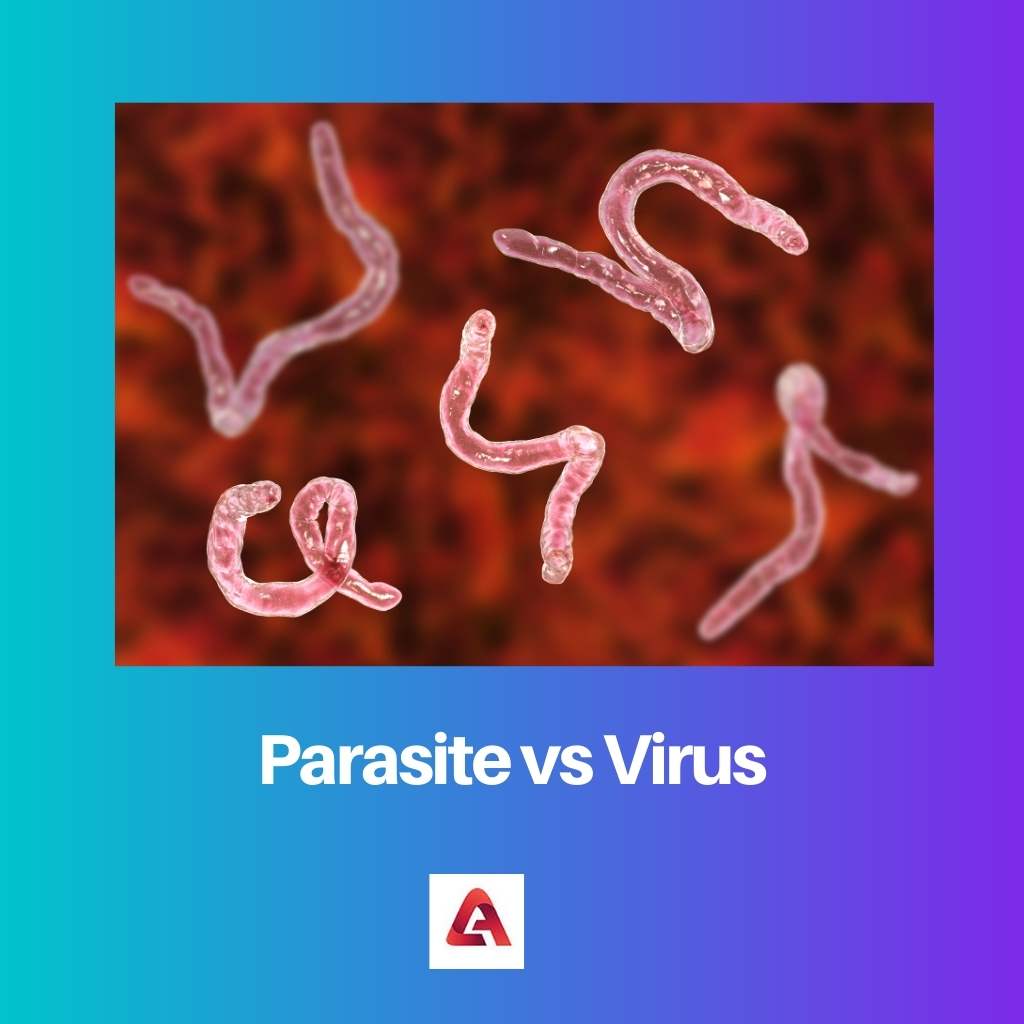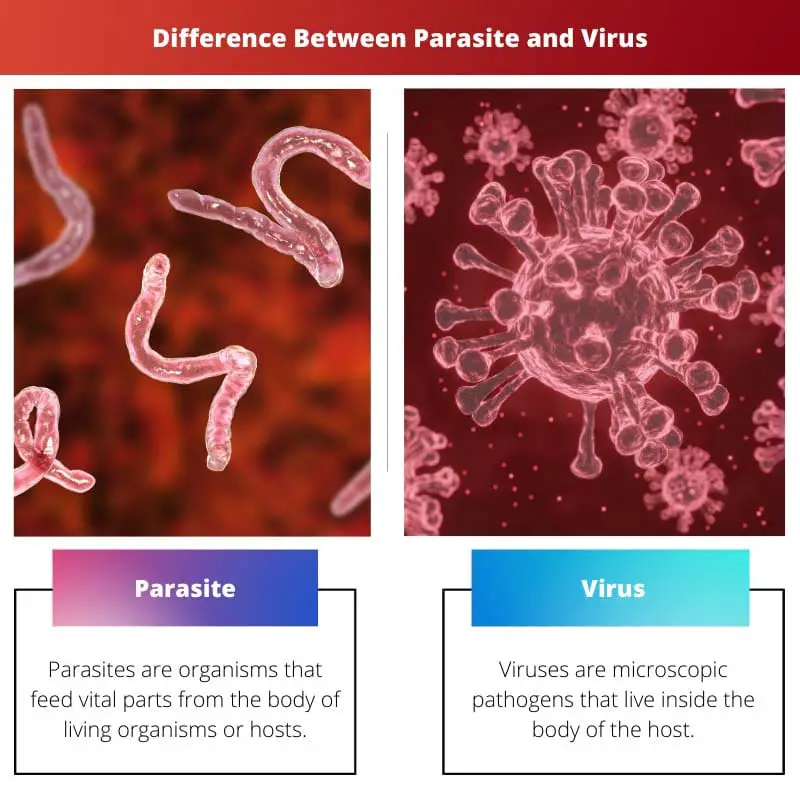Parasites and Viruses are microscopic organisms that survive inside the body of a host. Although they are minute creatures or organisms, they do have their basic features.
A parasite is eukaryotic and is considered living. It is also independent in terms of reproduction.
However, the virus is neither considered dead nor living. They can not survive independently but become active inside the body of a host. Besides, it feeds on the host and infects it.
To know more about them, we would further have a detailed study. Knowing their characteristics would help us to identify and distinguish them even in a proper way.
Key Takeaways
- Parasites are larger, living organisms that can survive outside a host, while viruses are smaller, non-living particles that need a host to reproduce.
- Parasites cause chronic infections, while viral infections can be acute or chronic.
- Treatment for parasites involves antiparasitic drugs, while antiviral medications treat viral infections.
Parasite vs Virus
A parasite is an organism that hosts other organisms of a different species to absorb nutrients at the cost of the host organism. Parasites can reproduce sexually and asexually. A virus is a microscopic organism that lives inside the body of the host. Viruses can only reproduce sexually inside the host’s body.

Parasites are eukaryotic organisms. They are found attached to living cells but can reproduce individually. They possess a well-defined nucleus. This causes severe disease in human beings.
Many parasites are common in animal intestines, such as tapeworms and fluke. They are bigger than viruses.
Viruses are known to be the smallest parasites to exist. They are mainly grouped based on their nature, which is single-stranded and double-stranded. The most commonly known diseases caused by animal viruses are polio and smallpox.
The most common way a virus enters the host is by horizontal or vertical transmission, which can be direct or indirect. They are microscopic and eukaryotic. They not only feed on the host but also affect them.
Comparison Table
| Parameters of Comparison | Parasites | Virus |
|---|---|---|
| Definition | Parasites are organisms that feed vital parts from the body of living organisms or hosts. | Viruses are microscopic pathogens that live inside the body of the host and also |
| Organization | They are eukaryotic organisms. It means their cells have a nucleus enclosed within a nuclear membrane. | They are non-cellular pathogens or structures. |
| Reproduction | They can produce both sexually as well as asexually. | They can not produce independently. They can only do so by living in the body of a host. |
| Localization | They come in contact with the host body to feed on it or live inside the host body, treating it as a habitat without harming it. | It lives inside living organisms, feeds on the host, and infects it as well. |
| Examples | Examples include Tapeworm, fluke, trichinella. | Examples include retrovirus, herpesvirus, adenovirus. |
What is Parasite?
Parasites are organisms that live inside the body of a host and treat it like its habitat. It can cause disease in humans and is classified into three types. They are protozoa, helminths, and ectoparasites.
They can multiply. This contributes to the survival of these organisms. Infection can be caused by just a single organism. They are eukaryotic.
In the case of human parasites, the transmission mostly takes place through the fecal-oral route.
Parasites are smaller than the size of the host but reproduce at a faster rate.
They are mostly known to affect the tropical and subtropical regions of the world. One of the deadliest known parasitic diseases is malaria.
All parasites do share some common features. The host they take advantage of can be either vertebrates or invertebrates.
Diagnosis of a parasite in the body can be made by faecal tests or blood tests. They can also result in inflammation.
If left untreated, they might bring serious conditions to our health. On the other hand, some of the minor parasitic infections tend to disappear on their own.
Tapeworms are the most commonly known parasites in the human body. They even result in the weakening of the immune system.

What is Virus?
Viruses are organisms that do not have the power to reproduce by themselves. However, they do multiply while living inside bodies. They can not perform a metabolic function without a host body.
They are of a very simple composition and microscopic. The name ‘Virus’ is derived from a Latin word that means poison.
Their genetic material is either DNA (deoxyribonucleic acid) or RNA (ribonucleic acid).
The main function of nucleic acid is to encode the genetic information which is particular to each virus. It comprises a protein that forms a protective shell around it, known as a capsid.
Due to the lack of ribosomes, they cannot synthesize protein. Also, they cannot store energy in the form of ATP. For this reason, they have the feature of deriving energy from the host cells.
They are classified into plant viruses and animal viruses. Some of the animal viruses can cause deadly diseases.

Main Differences Between Parasite and Virus
- One of the unique differences between parasites and Virus is their mode of reproduction. Parasites can either reproduce sexually or asexually, both independently. Whereas a virus can only multiply while living inside the host and deriving vital nutrients.
- Coming to their distinct cell structure, parasites are eukaryotic organisms with a well-defined nucleus. On the other hand, viruses are non-cellular structures. They do not contain a nucleus
- Now, coming to their localization. This basic feature helps to distinguish them quite properly. Both of them need a host for their survival, but the way they treat it differs. A parasite might stay connected to the host or inside it. A virus, however, lives inside the host and derives important nutrients and also affects the host.
- When it comes to definition, parasites are referred to as organisms, whereas viruses are referred to as pathogens. Both might be present in plants or animals. They get easily transmitted through various modes. Some of them cause serious diseases.
Last but not the least, examples. Both of them include organisms from different species. Parasites include tapeworm, fluke, and trichinella. Whereas virus includes pathogens such as retrovirus, herpesvirus, and adenovirus.




